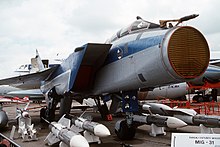
The Mikoyan-Gurevich MiG-25 is a supersonic interceptor and reconnaissance aircraft that is among the fastest military aircraft to enter service. Designed by the Soviet Union's Mikoyan-Gurevich bureau, it is an aircraft built primarily using stainless steel. It was to be the last plane designed by Mikhail Gurevich, before his retirement.

The Mikoyan MiG-31 is a supersonic interceptor aircraft developed for the Soviet Air Forces by the Mikoyan design bureau as a replacement for the earlier MiG-25 "Foxbat"; the MiG-31 is based on and shares design elements with the MiG-25.
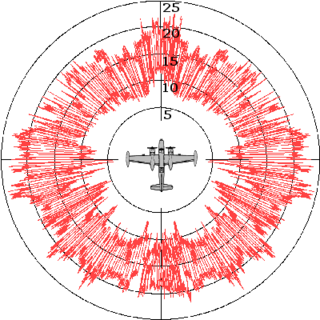
Radar cross-section (RCS), denoted σ, also called radar signature, is a measure of how detectable an object is by radar. A larger RCS indicates that an object is more easily detected.

The Mikoyan Project 1.44/1.42 is a multirole fighter technology demonstrator developed by the Mikoyan design bureau. It was designed for the Soviet Union's MFI project for the I-90 program, the answer to the U.S.'s Advanced Tactical Fighter (ATF). The MFI was to incorporate many fifth-generation jet fighter features such as supermaneuverability, supercruise, and advanced avionics, as well as some degree of radar signature reduction.

The Mikoyan MiG-29M is a Russian multirole fighter that first flew in 2005. The unified platform that is the MiG-29 is now comprised by the MiG-29M and a naval carrier variant, the MiG-29K. A direct predecessor of the MiG-29M, sometimes known informally as the "MiG-33", was developed by the Mikoyan design bureau in the mid-1980s.

The R-33 is a long-range air-to-air missile developed by Vympel. It is the primary armament of the MiG-31 interceptor, intended to attack large high-speed targets such as the SR-71 Blackbird, the B-1 Lancer bomber, and the B-52 Stratofortress.

The Buk is a family of self-propelled, medium-range surface-to-air missile systems developed by the Soviet Union and its successor state, the Russian Federation, and designed to counter cruise missiles, smart bombs, fixed- and rotary-wing aircraft, and unmanned aerial vehicles. In the Russian A2AD network, Buk is located between the S-200/300/400 systems above and the point defense Tor and Pantsir type systems below.
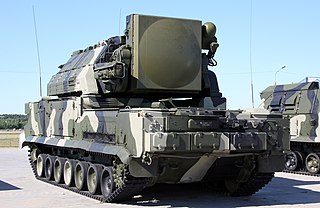
The Tor is an all-weather, low-to medium-altitude, short-range surface-to-air missile system designed for destroying airplanes, helicopters, cruise missiles, unmanned aerial vehicles and short-range ballistic threats (anti-munitions). Originally developed by the Soviet Union under the GRAU designation 9K330 Tor, the system is commonly known by its NATO reporting name, SA-15 "Gauntlet". A navalized variant was developed under the name 3K95 "Kinzhal", also known as the SA-N-9 "Gauntlet". Tor was designed to shoot down guided weapons like the AGM-86 ALCM and BGM-34 day and night, in bad weather and jamming situations. Tor can detect targets while on the move. The vehicle must stop intermittently when firing, although trials have been conducted with the goal of eliminating this restriction.

The Vympel R-37 is a Russian hypersonic air-to-air missile with very long range. The missile and its variants also had the names K-37, izdeliye 610 and RVV-BD, and the NATO codenames "Axehead" and "Andi". It was developed from the R-33.
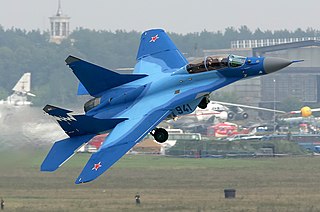
The Mikoyan MiG-29K is a Russian all-weather carrier-based multirole fighter aircraft developed by the Mikoyan Design Bureau. The MiG-29K was developed in the late 1980s from the MiG-29M. Mikoyan describes it as a 4+ generation aircraft.

The Kh-31 is a Soviet and Russian air-to-surface missile carried by aircraft such as the MiG-29,Su-27 and the Su-57. It is capable of Mach 3.5 and was the first supersonic anti-ship missile that could be launched by tactical aircraft.
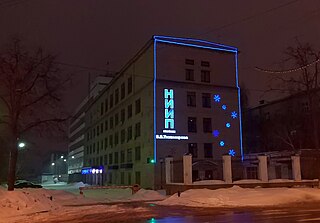
JSC V.V. Tikhomirov Scientific Research Institute of Instrument Design is a joint stock company, one of the Russian enterprises in the development of weaponry control systems for fighter planes and mobile medium range anti-aircraft SAM defence vehicles.

JSC Phazotron-NIIR is Russia's largest developer of military radars and avionics. Named after one of its major projects, the first cosmotron in the former-USSR, it was formed in June 1917 to produce aviation instruments. Its main office is located in Moscow and it has 25 affiliated companies, branches and separate units in Moscow and other cities in Russia and Belarus. It employs an estimated 5000 employees. During the Soviet era, it was commonly known as the Scientific Research Institute of Radar, NII Radar or NIIR.

The Zhuk are a family of Russian all-weather multimode airborne radars developed by NIIR Phazotron for multi-role combat aircraft such as the MiG-29 and the Su-27. The PESA versions were also known as the Sokol.
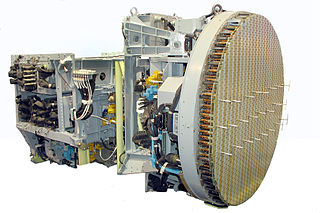
The Bars (Leopard) is a family of Russian all-weather multimode airborne radars developed by the Tikhomirov Scientific Research Institute of Instrument Design for multi-role combat aircraft such as the Su-27, Su-30 and the MiG-29.
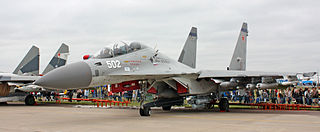
N001 Mech is a Russian all-weather multimode airborne radar developed by the Tikhomirov Scientific Research Institute of Instrument Design (NIIP) for the Su-27 multi-role combat aircraft.

The Mikoyan MiG-35 is a Russian multirole fighter that is designed by Mikoyan, a division of the United Aircraft Corporation (UAC). Marketed as a 4++ generation jet fighter, it is a further development of the MiG-29M/M2 and MiG-29K/KUB fighters. According to a Russian defense industry source, the Mikoyan MiG-35 is essentially an upgraded variant of the MiG-29KR. Many consider MiG-35 a new name given by Mikoyan for marketing. The first prototype was a modification of the aircraft that previously served as a MiG-29M2 model demonstrator given temporary name MiG-35 but a later prototype was a different model with different equipment that served as the base for the MiG-35 as is known today. Mikoyan first officially presented the MiG-35 internationally during the 2017 Moscow air show; the first two serial production aircraft entered service in 2019.
PAK DP is a Russian programme to develop a stealth interceptor aircraft/heavy fighter under development by Mikoyan to replace the Mikoyan MiG-31 in the Russian Aerospace Forces in mid-2030s. It is often referred to as the Mikoyan MiG-41, because its project code is izdeliye 41, but an official designation has not been given, as Russian planes only receive an official designation when they are about to enter service. According to Russian defence analyst Vasily Kashin, the MiG-41 would be considered a 6th generation project.
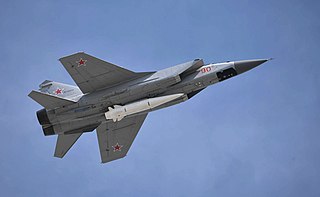
The Kh-47M2 Kinzhal is a Russian hypersonic air-launched ballistic missile. It has an estimated range of 460–480 km (290–300 mi) and a reported top speed of Mach 10. It can carry either conventional or nuclear warheads and can be launched by Tu-22M3 bombers or MiG-31K interceptors, also can be launched by modified Su-34 after Ukraine war. It is the first hypersonic weapon used.
